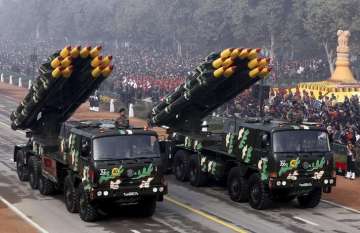In order to take on the two-front war threat from China and its “all-weather ally” Pakistan while safeguarding India’s expanding geostrategic interests, the armed forces have sought an allocation of Rs 26.84 lakh crore over the next five years to ensure the necessary military modernisation and maintenance.
According to a Times of India report, the Union defence ministry sources said that the 13th consolidated defence five-year plan for 2017-2022, which has been pegged at 26,83,924 crore after extensive consultations with all stakeholders, including the DRDO, was presented at the Union Commanders’ Conference here on July 10-11.
“The armed forces pitched for an early approval to the 13th Plan because their annual acquisition plans are based on it,” a source was quoted by Times of India as saying.
The move comes at a time when Indian and Chinese troops are locked in a tense face-off near the Sikkim-Bhutan-Tibet tri-junction, while the daily firing duels with Pakistan along the Line of Control (LoC) continues.
Union defence minister Arun Jaitley, who addressed the conference, asured the armed forces that capital expenditure for modernisation projects will be "a priority area" with resource availability increasing within the Indian economy.
However, it is true that the annual defence budgets have been showing a decline in modernisation budgets, with the Army, Navy and IAF continuing to grapple with critical operational gaps on several fronts.
In the 2017-18 defence budget, for instance, the Rs 1,72,774 crore revenue outlay by far outstrips the capital one of Rs 86,488 crore for new weapon systems and modernisation.
Furthermore, the Rs 2.74 lakh crore budget works out to just 1.56 per cent of the projected GDP, the lowest such figure since the 1962 war with China. “The forces want the defence budget to progressively reach at least 2% of the GDP for their operational requirements,” said a source.
The defence five-year plans are formulated in consonance with existing threat perceptions, the "Raksha Mantri's operational directives" and the 15-year LTIPP (long-term integrated perspective plan). But they have not received much attention from successive governments, with the 10th (2002-07), 11th (2007-12) and 12th (2012-17) Plans failing to get approval from the finance ministry.
Latest India News

